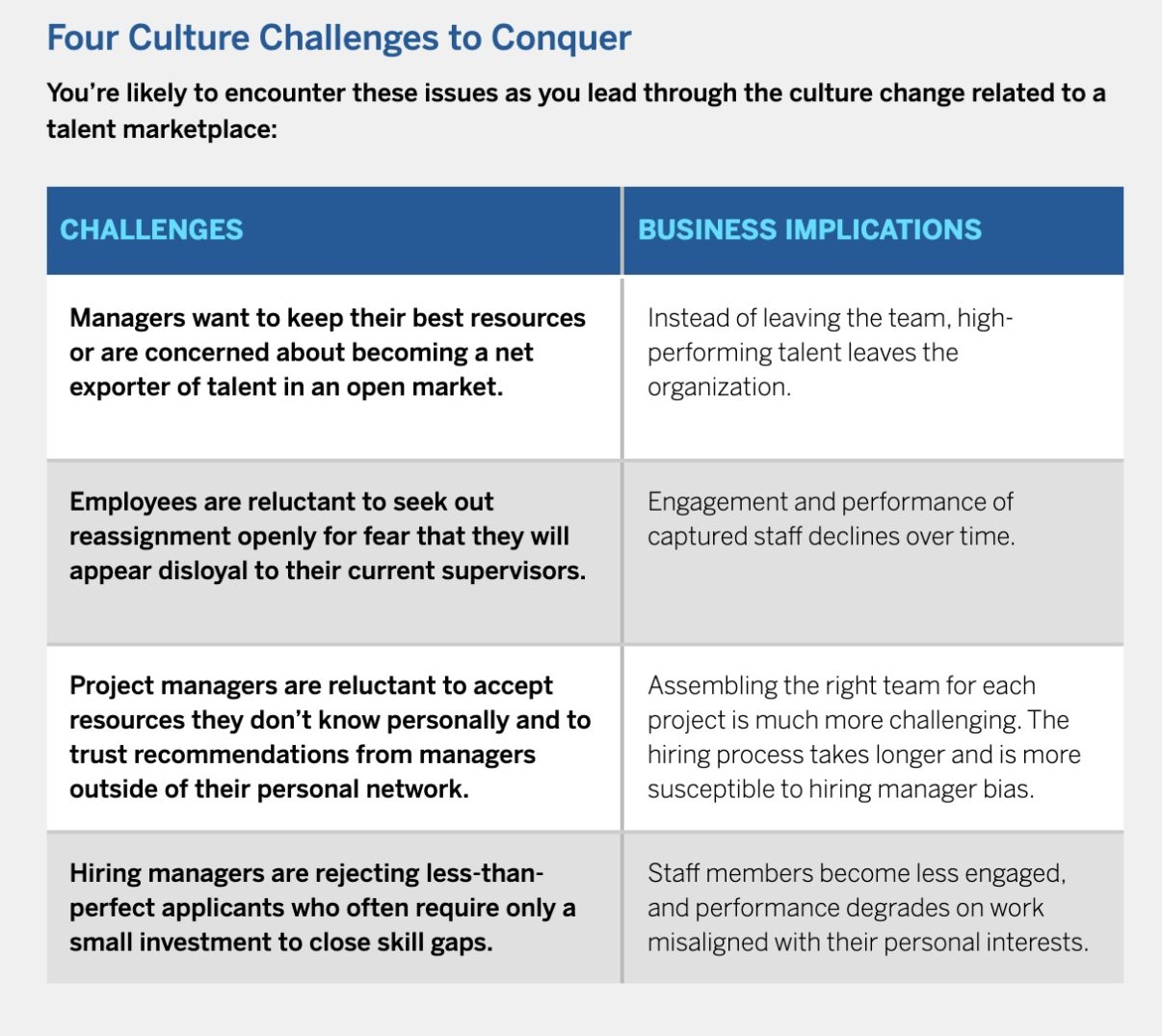How to Start Smart With a Talent Marketplace
Launching an internal talent marketplace presents tough challenges. Use one company’s first-year lessons learned on user adoption and change management.
News
- Gulf Nations Fast-Track AI Ambitions, UAE Leads Regional Readiness, says BCG Report
- AI Professionals form a Redefined Workforce. But Systemic Roadblocks Persist, Survey Finds
- AI-Driven Scams Surge as Microsoft Blocks $4 Billion in Fraud Attempts
- Identity-based Attacks Account for 60% of Leading Cyber Threats, Report Finds
- CERN and Pure Storage Partner to Power Data Innovation in High-Energy Physics
- CyberArk Launches New Machine Identity Security Platform to Protect Cloud Workloads

Carolyn Geason-Beissel/MIT SMR
Many leaders can now make a strong case for establishing an internal talent marketplace, but getting one off the ground remains difficult. At Booz Allen, we experienced that truth during the first year after launching our pilot project. Here, we’ll examine some of the challenges we faced, how we overcame them, and what we learned about change management and talent marketplaces.
Having a talent marketplace represented an important change for Booz Allen. For years, we’d been deploying professional staff members through informal, internal networks that operated based on who you knew and who you trusted. But this path limited our flexibility to make use of available resources and match the right talent to the right work. More importantly, it limited our people’s control over their own career paths, and that hurt engagement and retention.
To test a better approach, Booz Allen launched a talent marketplace pilot project in partnership with Lotis Blue Consulting in January 2022. With the pilot, we sought to address talent management challenges that constrained growth and hurt our ability to deliver a compelling value proposition to employees — namely, issues in hiring, deployment, talent development, technology and its adoption, and culture change. We wanted to solve these problems systematically and holistically rather than introduce point solutions, which often fail to compound value.
But the level of cultural transformation required to activate and operate a talent marketplace is significant. It takes a sustained effort to work through several human behavioral- and perception-driven issues — and overcoming these issues is key to success.
The Road to a Talent Marketplace
Booz Allen wanted to end its reliance on traditional hiring networks centered around clients or teams. These highly localized networks made it tough to find resources in other parts of the organization that would meet enterprise, regional, or local needs. In contrast, the marketplace established a centralized approach to assess demand and source talent enterprisewide (via external hiring, internal deployment, or upskilling) and created the capability to deploy people across the entire organization.
The marketplace pilot focused on skills rather than networks. This gave employees new visibility to open opportunities across the enterprise and managers new insights into talent who could do the work. This high-resolution view on job and development opportunities vastly expanded the scope of what people could explore, improving employee engagement and delivering higher levels of individual and business performance. The pilot doubled the internal fill rate on open positions for the pilot population and garnered positive employee feedback on transparency and ease of pursuing new opportunities. Additionally, this skills-based approach gave underrepresented candidates more opportunities in technical domains with public sector clients.
In the early months of the pilot, we needed to overcome a few important challenges to build interest and excitement. Most importantly, we needed to seed the marketplace with a sufficient number of high-quality opportunities and available talent to engage both employees and managers. In so doing, we learned several important lessons — especially around change management.
Lesson 1: Bring on the gamification.
As our clients’ environments and needs are changing, the nature of our work is evolving, and we are seeing a rapid shift in in-demand skill sets. Our technical talent’s ability to deliver against a client’s mission depends on how quickly they can learn and adapt.
To address this, Jim Hemgen, Booz Allen’s strategic talent development leader, and his learning and development (L&D) team designed and launched a badging program alongside the marketplace pilot. The program aimed to develop strategic enterprise capabilities by illuminating different career pathways and the skills required to access different opportunities. To qualify for a badge, an employee needed to both earn the credential and have a manager validate that they had applied the skill on the job. This gamified learning and offered recognition and rewards to employees who invested in their own development.
The L&D team engaged a large segment of the company’s technical workforce in building strategic capabilities through a combination of internal badging and external certifications. In the past year, employees have earned more than 4,000 badges or certifications that are critical to the future of the business.
Lesson 2: Data goals must be relevant to individual career goals.
We encountered several technical challenges associated with the pilot, including data structure (establishing the right job architecture), data quality (ensuring that skills data was complete, for example), and algorithm design (how best to perform the recommendation process for talent and open positions).
To get the complete skills data, we needed wide adoption. In reality, adoption closely correlated with the value that users expected to extract from the platform. We had a slow start as employees and managers explored the functionality and benefits.
That changed once John Grumbine, the marketplace operations leader, helped launch the Career Hub, an internal web app, in January 2023. The app served as a one-stop shop for employees to find jobs, training and development, mentors, and communities in the talent marketplace based on their skills and preferences. Employees now had a vested interest in keeping their skills and preferences up to date because that information drove recommendations for the opportunities, training, and the mentors they could access; further, it drove how they might be discovered or identified by project managers seeking to fill roles.
Launching the Career Hub app led to a substantial increase in talent marketplace adoption. As of September 2023, more than 50% of Booz Allen employees had onboarded into the Career Hub and were accessing job, learning, and mentoring opportunities.
Lesson 3: Even change management needs to change.
In the realm of cultural transformation, we quickly experienced four key challenges after launching the pilot. (See “Four Culture Challenges to Conquer.”)

Those challenges were causing a lot of problems. In response, our team prioritized several important actions to drive the culture change we needed:
- Build, refine, and map out skills-based talent profiles to provide greater clarity on the work people can do or have done.
- Focus (initially) on high-volume in-demand job profiles to create enough liquidity in the system that participants have the opportunity to move.
- Form a small, agile, and action-oriented operations team to collaborate with subject matter experts (for example, from business leadership and talent acquisition) as different challenges arise.
- Provide human-centric support in the form of marketplace navigators — people specifically tasked with helping all participants (employees and managers) follow marketplace rules and guidelines and get the most value from the platform.
All of these steps can be built into a launch plan for a talent marketplace.
Lesson 4: Momentum, motivation, and measurement matter a great deal.
At a high level, it’s important to launch several services of an integrated talent management system simultaneously in order to exceed expectations and build adoption momentum.
To effect behavioral change, leaders must deeply understand what motivates different people, as well as how the changes they’re making will address people’s needs. The pilot provided valuable feedback on marketplace utility, helped prioritize enhancements, and established the level of change management required to support evolving and scaling the design.
Monitoring and measuring marketplace performance helped our team try new things, fail fast, and continually enhance the marketplace’s value to participants. More specifically, our metrics included the number of opportunities posted, trends within those opportunities, the level and breadth of employee interest by type of posting, the percentage of aging opportunities (those that went unfilled for a long time), and the percentage of positions filled. This data helped us evaluate the health and strength of the platform and gave us insight into how system adjustments were influencing performance.
Commit to Continuous Improvement
Through the talent marketplace and our other talent system investments, we are delivering a better employee value proposition. Our employee retention improved more than 4% after the pilot. However, this journey never ends. Continuous investment in evolving talent, as well as the solution, is essential to success for the business.
Addressing obstacles that come up along the way is part of the journey and ultimately leads to a better design and better results. A talent marketplace offers important benefits in today’s evolving labor market: By prioritizing employee mobility and development, companies can better adapt to the changing skill requirements and realize higher levels of innovation, collaboration, and flexibility within their workforces.





